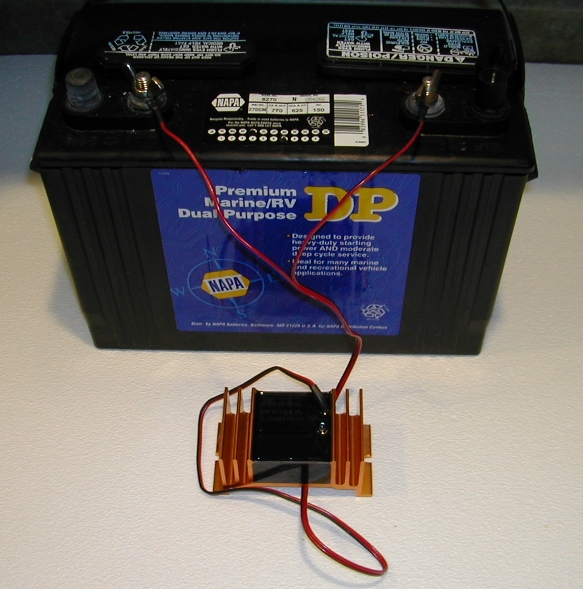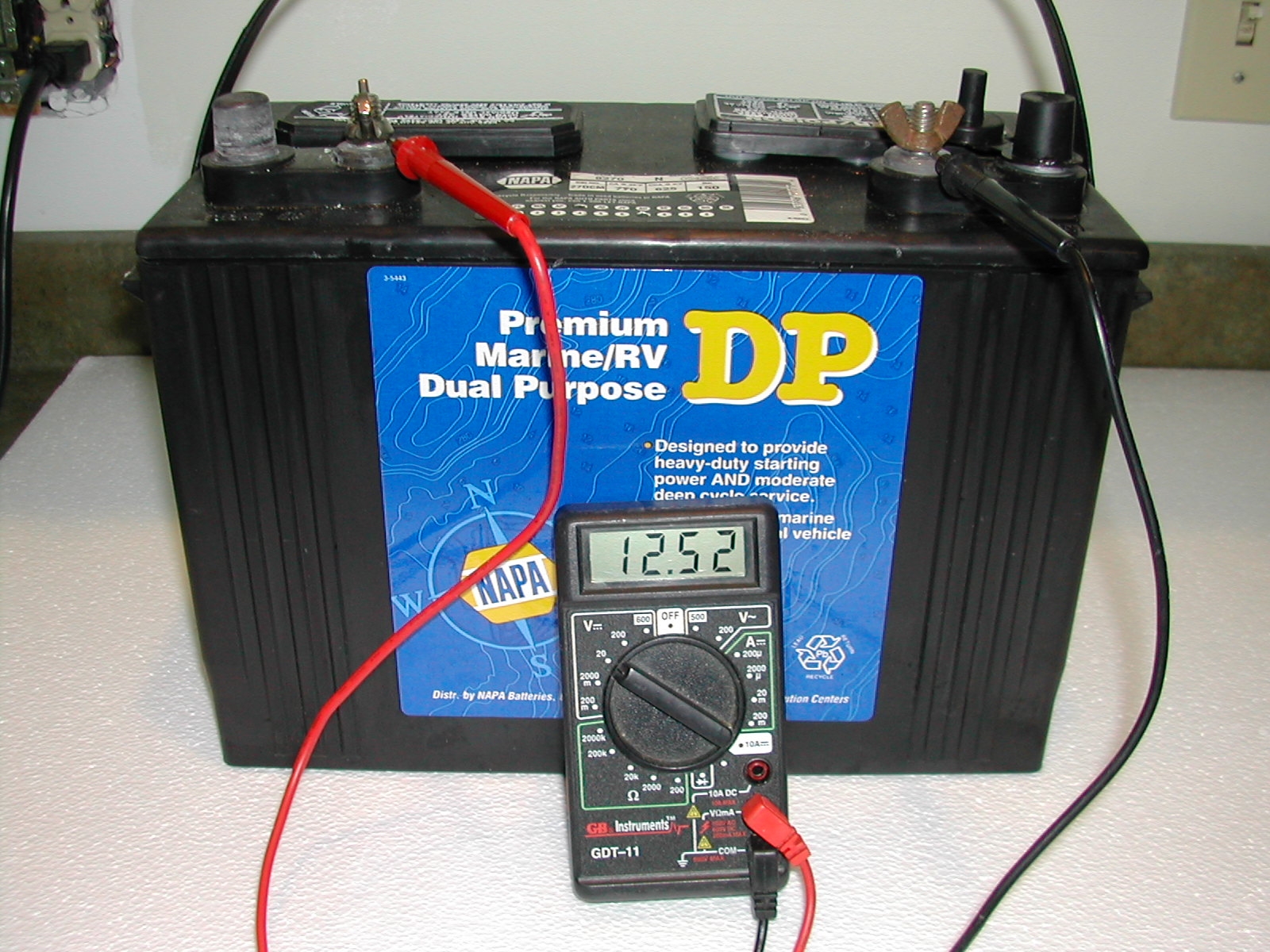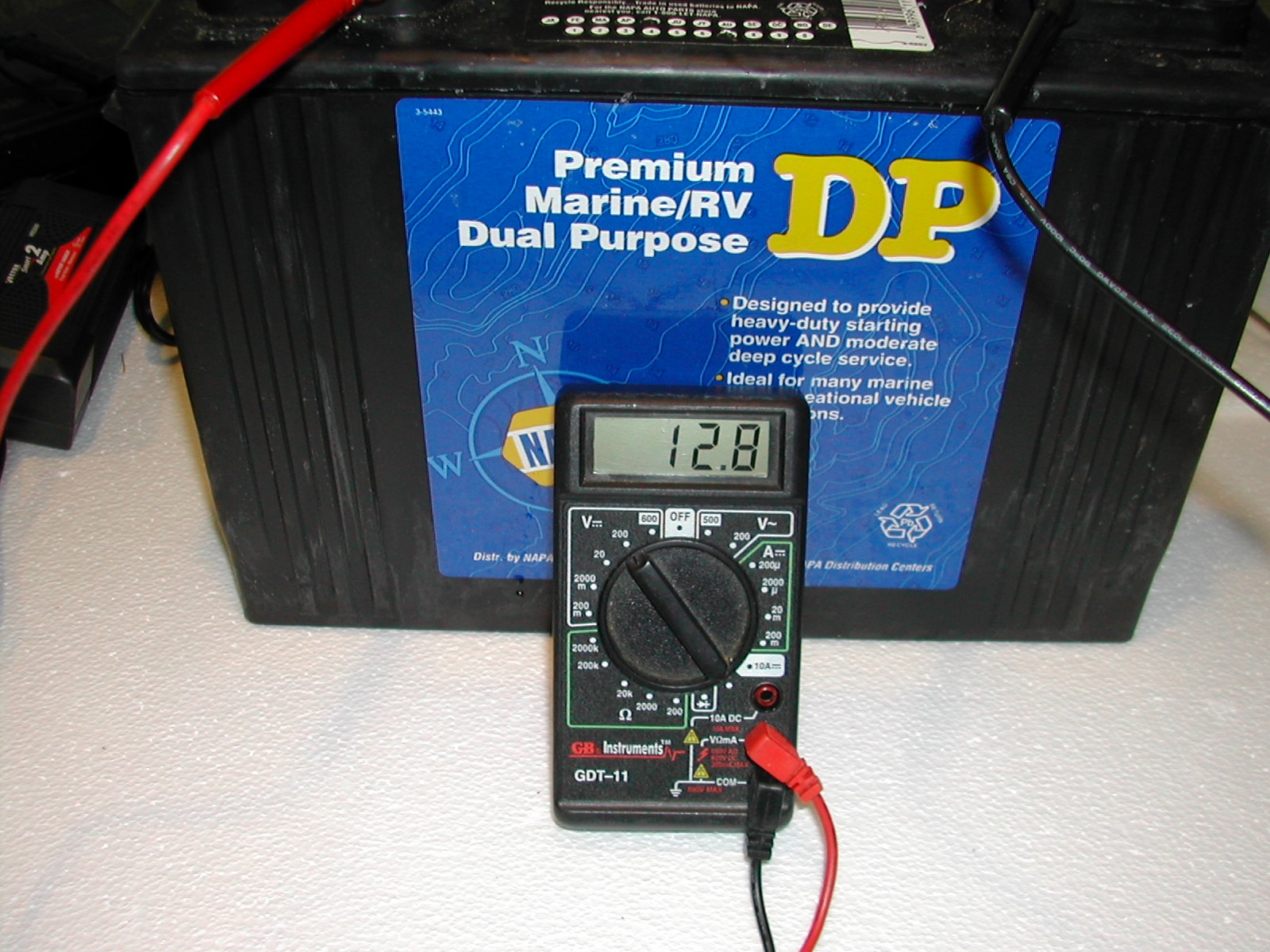
Does
This Really Work?
I
couldn't help but wonder if the BLS really works. I'm a
boater so one of the
things
that you have to do every three years is replace the batteries, right?.
In my boat I have three batteries, two starting batteries and
one house battery. when I purchased this boat in May of 2007
three brand new NAPA #8270 Dual Purpose Premium Marine/RV were
installed.
In our neck of the woods our boats are stored from October to
May. The rest of the time they are mostly sitting tied up to
a dock plugged into a charger. So for at least six months the
batteries see no activity and the other six months that are getting
charged.
Near the
end of the summer I started having problems starting one engine.
I checked the battery voltage on each battery. It was right
where it was supposed to be. I was thinking, bad starter, bad battery
switch, water
in the engine, everything but the battery. After being
stranded twice with only one motor starting I had to do something.
.
I removed the battery that seemed to be the problem and took it over to
the NAPA store. They
have a simple device that measures voltage and cold cranking amperage.
As I said the voltage was right on.
However with their
tester the CCA was reading only 430. This is about 70% of the
625 CCA rating at 0 degrees F. So, even though the
voltage
was reading OK, the actual power in the battery was low. Out
of
desperation I ordered a new battery. That is what
we usually do, right? So I got my new battery,
installed it and the motor started just like it is supposed to.
I was a genius!
I got to thinking, I sell these BLS units that are supposed to restore
a battery back to life by removing sulfate crystals from the surface of
the battery cell plates.
What if I purchase one of these just like a regular customer
and see if it really works. So I ordered my "Battery Solver
Package" for a single 12V battery and waited for it to arrive.
It came in a nice box with all the stuff required to fix up a battery.
In addition to the Battery Solver Package I also needed
a "Hydrometer"
and a Volt Meter to do my test so I could tell you if it was really
working. I was ready to see if this electronic
gizmo really
worked. I already had a volt meter but had to order a
Hydrometer
form Flow-Rite Controls. I was ready to begin my test.
Without thinking a lot about how I was going to do this test I
proceeded to follow the easy to read directions included in the BLS
Package. Now I didn't follow
the directions exactly as they specified. It was over the
weekend
and there was football and sleep and other stuff going on.
The time elements specified for the LIFE SAVING adventure
were not exactly
as you would say, according to hoyle. But I though they were
close enough. The re-juvinating process was begun on a
Thursday morning and finished on a Monday afternoon
in about
100 hours.
The interesting thing about
batteries is that most of us common folks don't really understand what
is going on inside of them. We just use them and use them
until they quit and then we buy a new one and start all over again.
This makes the battery supplier happy and also
makes us happy. We turn the key and off we go again.
However
I guess the folks at BLS really do understand what is going on inside
these
black cases and are able to scientifically restore them to a like new
condition.
Now the BLS part of this kit is a unit that actually uses the power of
the battery to send high frequency
wave through the battery. These high frequency waves actually
melt the sulfuric crystals that are growing on the plates and returns
them into solution. It keeps doing this over and over all the
time that it is attached to the battery. This is different
than
the process called equalizing. Equalizing is really charging
the battery at a higher than normal voltage, usually about 14.5v.
This high voltage causes the crystals to flake off and fall
into the bottom of the battery. So now you have cleaner cell
plates but the solution has been diluted by the flakes just falling to
the
bottom of the battery. So each time you equalize you are
actually diluting the acid solution inside your battery, thus not
allowing the
battery to ever reach its full potential.
But does it really work?
After I figured out what I was doing I managed to keep some petty good
reading on what was happening.
I made a chart showing the specific gravity reading after
each cycle of the BLS cycle and the charger cycle. The
results can
be seen below.
| Order
of Test |
Voltage
@ end of cycle |
CCA
@ 70 Degrees F |
Hours
on Charger |
Hours
on BLS |
Cell
# |
Specific
Gravity @ 70 Degrees C |
%
of Discharge |
| Start |
12.5 |
430 |
|
|
|
|
20 |
| BLS
Cycle |
12.5 |
|
|
19 |
1 |
1.25 |
20 |
|
|
|
|
|
2 |
1.25 |
|
|
|
|
|
|
3 |
1.25 |
|
|
|
|
|
|
4 |
1.243 |
|
|
|
|
|
|
5 |
1.242 |
|
|
|
|
|
|
6 |
1.238 |
|
| 2
AMP Charger |
13.7 |
|
7 |
|
1 |
1.26 |
14 |
|
|
|
|
|
2 |
1.26 |
|
|
|
|
|
|
3 |
1.26 |
|
|
|
|
|
|
4 |
1.258 |
|
|
|
|
|
|
5 |
1.258 |
|
|
|
|
|
|
6 |
1.238 |
|
| BLS
Cycle |
12.45 |
|
|
18 |
1 |
1.258 |
14 |
|
|
|
|
|
2 |
1.258 |
|
|
|
|
|
|
3 |
1.257 |
|
|
|
|
|
|
4 |
1.256 |
|
|
|
|
|
|
5 |
1.248 |
|
|
|
|
|
|
6 |
1.25 |
|
2
Amp
Charger |
13.25 |
|
12 |
|
1 |
1.27 |
5 |
|
|
|
|
|
2 |
1.267 |
|
|
|
|
|
|
3 |
1.265 |
|
|
|
|
|
|
4 |
1.268 |
|
|
|
|
|
|
5 |
1.26 |
|
|
|
|
|
|
6 |
1.254 |
|
| BLS
Cycle |
12.7 |
|
|
12.5 |
1 |
1.26 |
|
|
|
|
|
|
2 |
1.26 |
|
|
|
|
|
|
3 |
1.265 |
|
|
|
|
|
|
4 |
1.268 |
|
|
|
|
|
|
5 |
1.26 |
|
|
|
|
|
|
6 |
1.255 |
|
| 2
Amp Charger |
12.8 |
823
24 Hrs Later |
26 |
|
1 |
1.27 |
5 |
|
|
|
|
|
2 |
1.27 |
|
|
|
|
|
|
3 |
1.27 |
|
|
|
|
|
|
4 |
1.27 |
|
|
|
|
|
|
5 |
1.265 |
|
|
|
|
|
|
6 |
1.263 |
|

Start
|

End
|
Observations-
The first cycle using the BLS did not yield any noticeable differences
in the % of discharge.
After the first charge cycle at 2 amps the voltage was reading 13.7
volts. The charger was
quite hot. This is part of the normal working of the charger.
It is sensing lower state of charge so kicks up the voltage
to fully charge the
battery. The % of discharge went down from 20 to 14.
After the second cycle using the BLS the voltage dropped to 12.45
volts. This is normal
because the BLS is using the power of the battery to run on .
After the second charge at 2 amps the voltage was reading 13.25V.
There was still a high demand
from the battery to fully charge the battery. The specific
gravity had
improved to 1.255-1.268. This is a drastic improvement.
The
percentage of discharge relative to the chart 5%.
After the third cycle using the BLS the voltage has improved over the
previous BLS cycle from 12.45 to
12.7. This would indicate that the BLS is still working since
it had started at 13.25V after the charging cycle. The third
cycle time was 12.5 hours, about six hours less than the first BLS
cycles.
After the third charge cycle at 2 amps the voltage had calmed down to
12.8 volts after 26 hours of
charging. This is a normal voltage at 100% charge after the
battery has gone into a float mode.
Final Results-At the end of the test the volt meter showed
12.8 volts at the end of a
26 hour 2 amp charge cycle. The specific gravity at the end
on this charge cycle showed reading from 1.27 to 1.263. After
24
hours the battery was taken to the local NAPA store and was tested
using the same test instrument as used before the test was started.
The final reading on the NAPA tester was 823 CCA @ 70 degrees
F, and 12.82 volts. Relative to the BLS chart the state of
charge was 100% at 1.27 specific gravity.
Final Conclusion-
the Battery Life Saver device truly works. The results at the
end of the test reflect numbers that you would find with a new battery.
I can only conclude that the battery plates were sulfated
before the test was begun. At the end of the charging-bls
cycles
the CCA were fully restored.
Certainly results may vary with the current condition of your
batteries. But the results are
conclusive that the BLS works. The benefits will be greater
on items like golf carts, EV's, solar installation, and any other
multiple
battery installation. The BLS is available from 12V to 156
volts and is matched to the voltage of the system charger and not the
individual voltage of the battery.
Link-
Testing Batteries to See If They Can Be Restored
Link-
Battery Life Saver
Link-
Battery Solver Package
Print Test Report
|